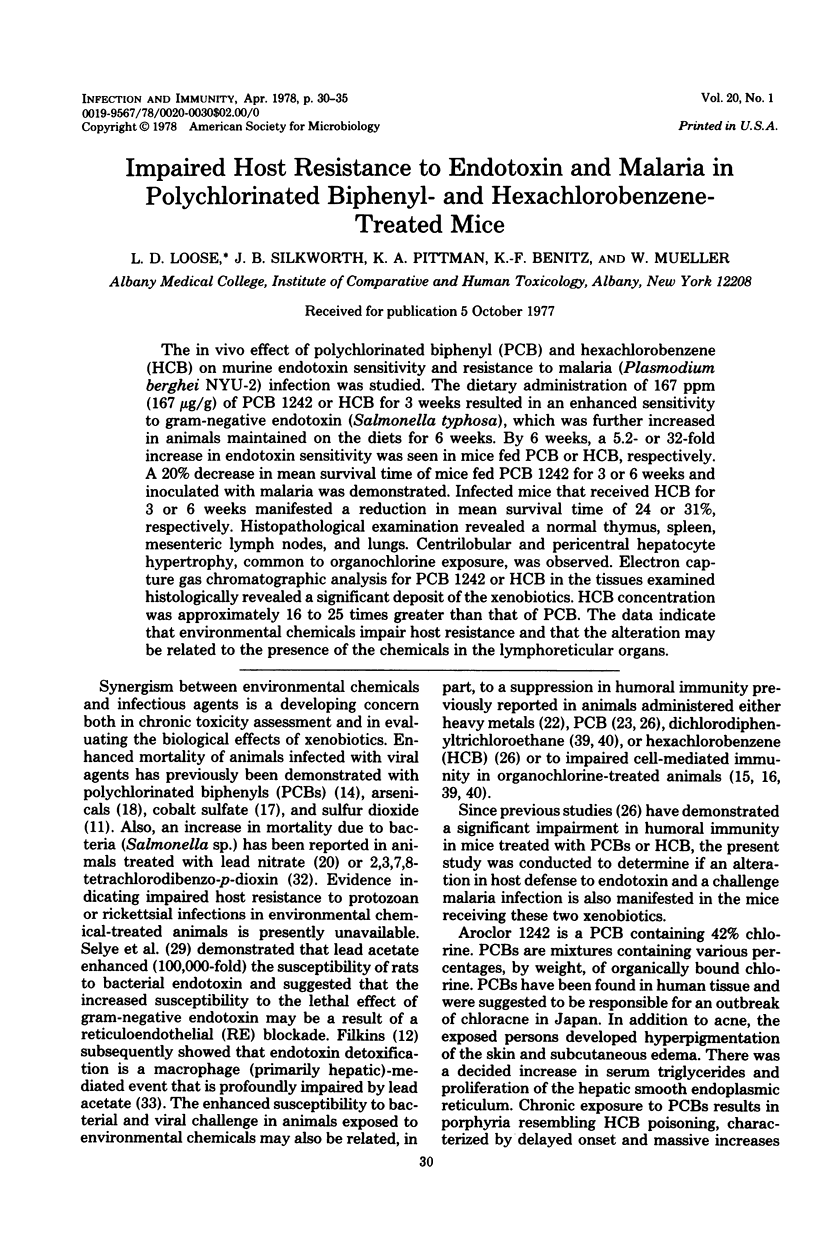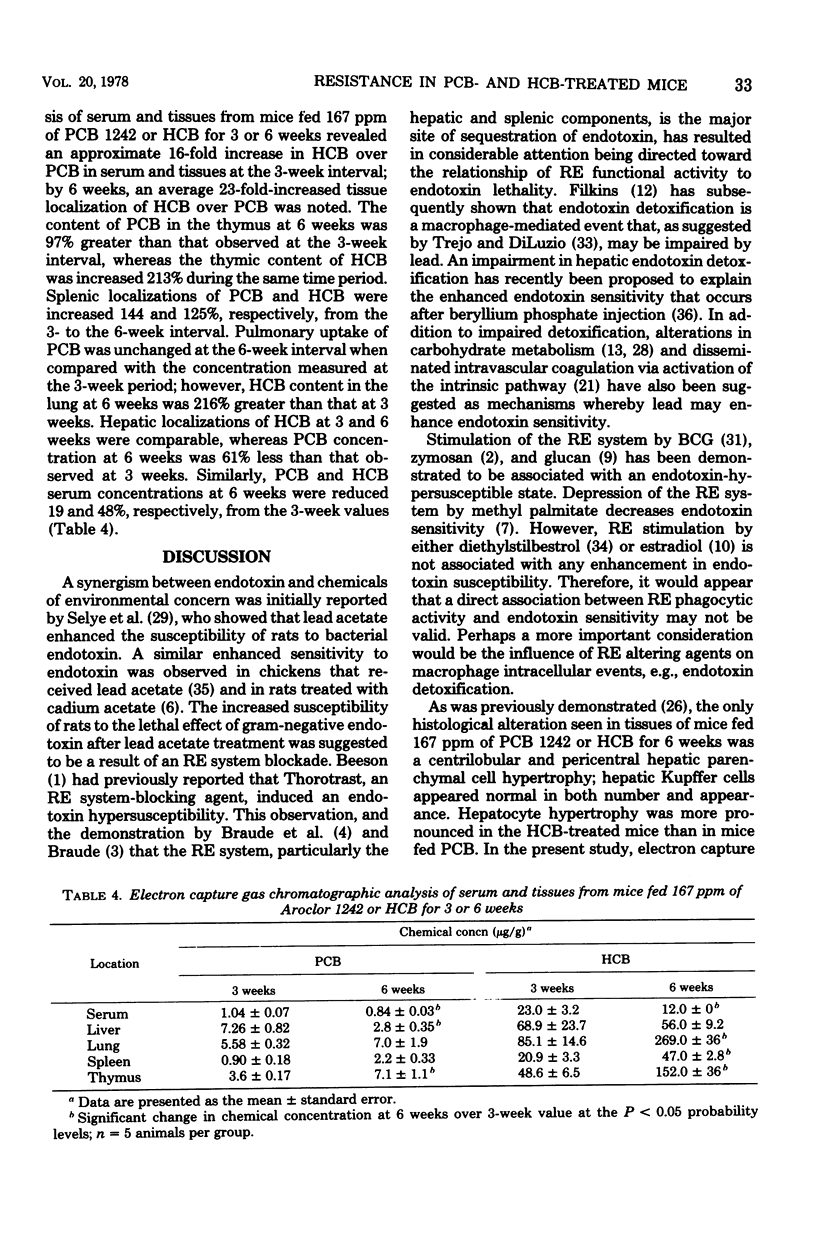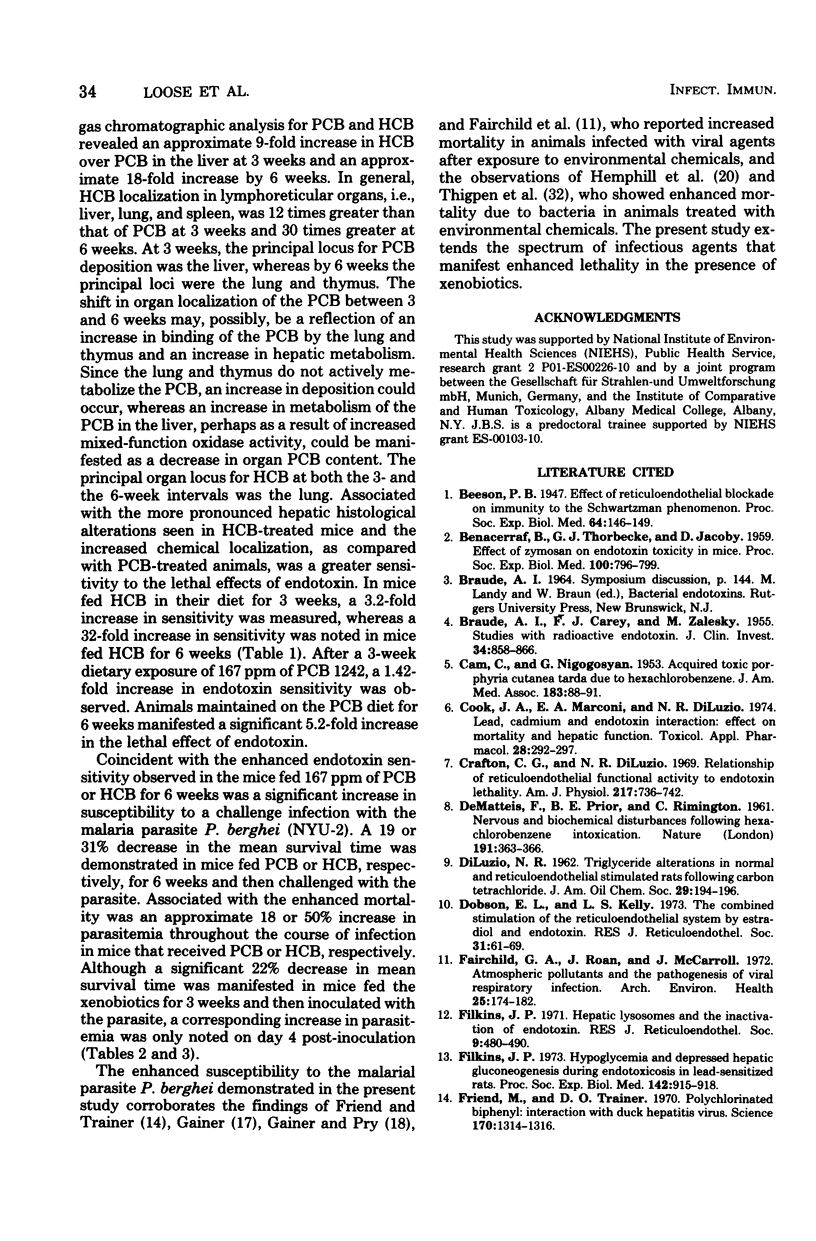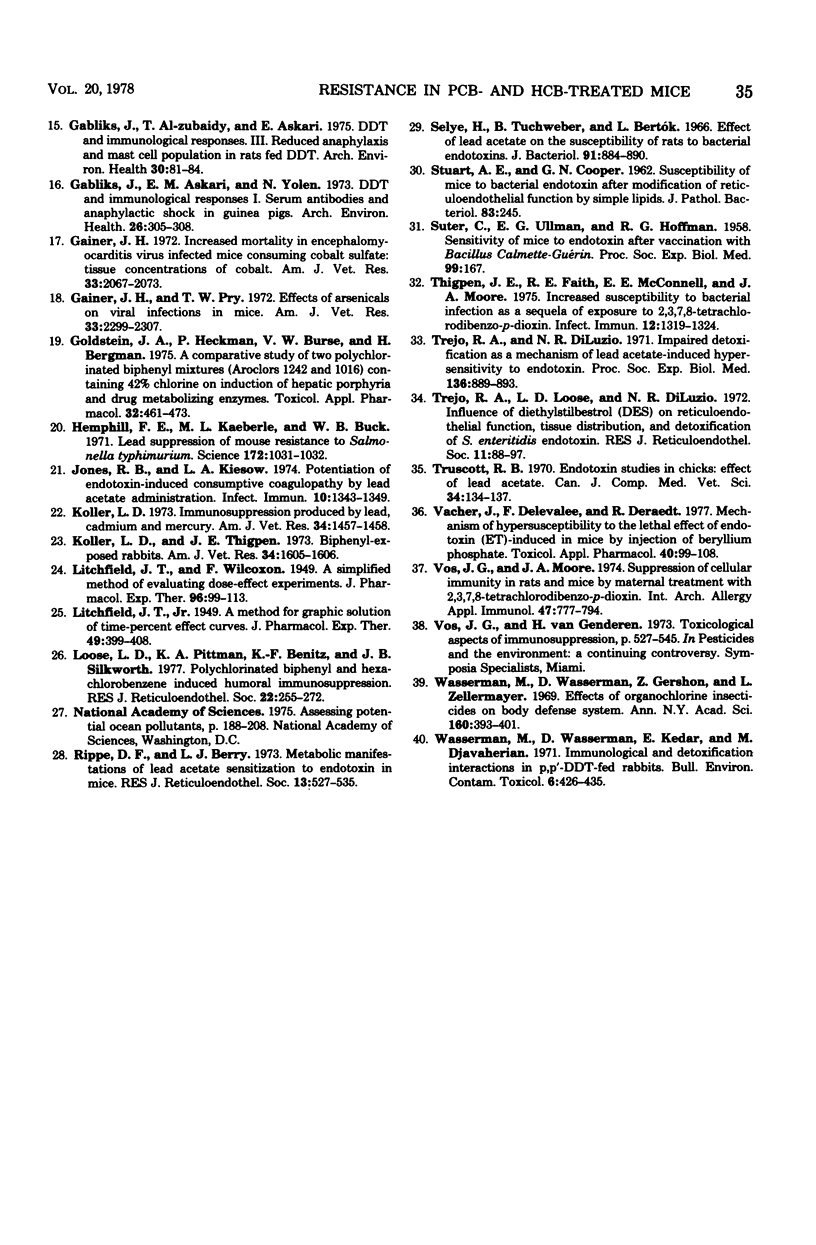Abstract
The in vivo effect of polychlorinated biphenyl (PCB) and hexachlorobenzene (HCB) on murine endotoxin sensitivity and resistance to malaria (Plasmodium berghei NYU-2) infection was studied. The dietary administration of 167 ppm (167 microgram/g) of PCB 1242 or HCB for 3 weeks resulted in an enhanced sensitivity to gram-negative endotoxin (Salmonella typhosa), which was further increased in animals maintained on the diets for 6 weeks. By 6 weeks, a 5.2- or 32-fold increase in endotoxin sensitivity was seen in mice fed PCB or HCB, respectively. A 20% decrease in mean survival time of mice fed PCB 1242 for 3 or 6 weeks and inoculated with malaria was demonstrated. Infected mice that received HCB for 3 or 6 weeks manifested a reduction in mean survival time of 24 or 31%, respectively. Histopathological examination revealed a normal thymus, spleen, mesenteric lymph nodes, and lungs. Centrilobular and pericentral hepatocyte hypertrophy, common to organochlorine exposure, was observed. Electron capture gas chromatographic analysis for PCB 1242 or HCB in the tissues examined histologically revealed a significant deposit of the xenobiotics. HCB concentration was approximately 16 to 25 times greater than that of PCB. The data indicate that environmental chemicals impair host resistance and that the alteration may be related to the presence of the chemicals in the lymphoreticular organs.
Full text
PDF





Selected References
These references are in PubMed. This may not be the complete list of references from this article.
- BENACERRAF B., THORBECKE G. J., JACOBY D. Effect of zymosan on endotoxin toxicity in mice. Proc Soc Exp Biol Med. 1959 Apr;100(4):796–799. doi: 10.3181/00379727-100-24781. [DOI] [PubMed] [Google Scholar]
- BRAUDE A. I., CAREY F. J., ZALESKY M. Studies with radioactive endotoxin. II. Correlation of physiologic effects with distribution of radioactivity in rabbits injected with radioactive sodium chromate. J Clin Invest. 1955 Jun;34(6):858–866. doi: 10.1172/JCI103141. [DOI] [PMC free article] [PubMed] [Google Scholar]
- CAN C., NIGOGOSYAN G. Acquired toxic porphyria cutanea tarda due to hexachlorobenzene. Report of 348 cases caused by this fungicide. JAMA. 1963 Jan 12;183:88–91. [PubMed] [Google Scholar]
- Cook J. A., Marconi E. A., Di Luzio N. R. Lead, cadmium, endotoxin interaction: effect on mortality and hepatic function. Toxicol Appl Pharmacol. 1974 May;28(2):292–302. doi: 10.1016/0041-008x(74)90016-7. [DOI] [PubMed] [Google Scholar]
- Crafton C. G., Di LUZIO N. R. Relationship of reticuloendothelial functional activity to endotoxin lethality. Am J Physiol. 1969 Sep;217(3):736–742. doi: 10.1152/ajplegacy.1969.217.3.736. [DOI] [PubMed] [Google Scholar]
- DE MATTEIS F., PRIOR B. E., RIMINGTON C. Nervous and biochemical disturbances following hexachlorobenzene intoxication. Nature. 1961 Jul 22;191:363–366. doi: 10.1038/191363a0. [DOI] [PubMed] [Google Scholar]
- Dobson E. L., Kelly L. S. The combined stimulation of the reticuloendothelial system by estradiol and endotoxin. J Reticuloendothel Soc. 1973 Jan;13(1):61–69. [PubMed] [Google Scholar]
- Fairchild G. A., Roan J., McCarroll J. Atmospheric pollutants and the pathogenesis of viral respiratory infection. Sulfur dioxide and influenza infection in mice. Arch Environ Health. 1972 Sep;25(3):174–182. doi: 10.1080/00039896.1972.10666157. [DOI] [PubMed] [Google Scholar]
- Filkins J. P. Hepatic lysosomes and the inactivation of endotoxin. J Reticuloendothel Soc. 1971 May;9(5):480–490. [PubMed] [Google Scholar]
- Filkins J. P. Hypoglycemia and depressed hepatic gluconeogenesis during endotoxicosis in lead-sensitized rats. Proc Soc Exp Biol Med. 1973 Mar;142(3):915–918. doi: 10.3181/00379727-142-37143. [DOI] [PubMed] [Google Scholar]
- Friend M., Trainer D. O. Polychlorinated biphenyl: interaction with duck hepatitis virus. Science. 1970 Dec 18;170(3964):1314–1316. doi: 10.1126/science.170.3964.1314. [DOI] [PubMed] [Google Scholar]
- Gabliks J., Al-zubaidy T., Askari E. DDT and immunological responses. 3. Reduced anaphylaxis and mast cell population in rats fed DDT. Arch Environ Health. 1975 Feb;30(2):81–84. doi: 10.1080/00039896.1975.10666648. [DOI] [PubMed] [Google Scholar]
- Gabliks J., Askari E. M., Yolen N. DDT and immunological responses. I. Serum antibodies and anaphylactic shock in guinea pigs. Arch Environ Health. 1973 Jun;26(6):305–308. doi: 10.1080/00039896.1973.10666287. [DOI] [PubMed] [Google Scholar]
- Gainer J. H. Increased mortality in encephalomyocarditis virus-infected mice consuming cobalt sulfate: tissue concentrations of cobalt. Am J Vet Res. 1972 Oct;33(10):2067–2073. [PubMed] [Google Scholar]
- Gainer J. H., Pry T. W. Effects of arsenicals on viral infections in mice. Am J Vet Res. 1972 Nov;33(11):2299–2307. [PubMed] [Google Scholar]
- Goldstein J. A., Hickman P., Burse V. W., Bergman H. A comparative study of two polychlorinated biphenyl mixtures (Aroclors 1242 and 1016) containing 42% chlorine on induction of hepatic porphyria and drug metabolizing enzymes. Toxicol Appl Pharmacol. 1975 Jun;32(3):461–473. doi: 10.1016/0041-008x(75)90111-8. [DOI] [PubMed] [Google Scholar]
- Hemphill F. E., Kaeberle M. L., Buck W. B. Lead suppression of mouse resistance to Salmonella typhimurium. Science. 1971 Jun 4;172(3987):1031–1032. doi: 10.1126/science.172.3987.1031. [DOI] [PubMed] [Google Scholar]
- Jones R. B., Kiesow L. A. Potentiation of endotoxin-induced consumptive coagulopathy by lead acetate administration. Infect Immun. 1974 Dec;10(6):1343–1349. doi: 10.1128/iai.10.6.1343-1349.1974. [DOI] [PMC free article] [PubMed] [Google Scholar]
- Koller L. D. Immunosuppression produced by lead, cadmium, and mercury. Am J Vet Res. 1973 Nov;34(11):1457–1458. [PubMed] [Google Scholar]
- Koller L. D., Thigpen J. E. Biphenyl-exposed rabbits. Am J Vet Res. 1973 Dec;34(12):1605–1606. [PubMed] [Google Scholar]
- LITCHFIELD J. T., Jr A method for rapid graphic solution of time-per cent effect curves. J Pharmacol Exp Ther. 1949 Dec;97(4):399-408, 3 tab. [PubMed] [Google Scholar]
- Rippe D. F., Berry L. J. Metabolic manifestations of lead acetate sensitization to endotoxin in mice. J Reticuloendothel Soc. 1973 Jun;13(6):527–535. [PubMed] [Google Scholar]
- STUART A. E., COOPER G. N. Susceptibility of mice to bacterial endotoxin after modification of reticulo-endothelial function by simple lipids. J Pathol Bacteriol. 1962 Jan;83:245–254. doi: 10.1002/path.1700830126. [DOI] [PubMed] [Google Scholar]
- SUTER E., ULLMAN G. E., HOFFMAN R. G. Sensitivity of mice to endotoxin after vaccination with BCG (Bacillus Calmette-Guérin). Proc Soc Exp Biol Med. 1958 Oct;99(1):167–169. doi: 10.3181/00379727-99-24282. [DOI] [PubMed] [Google Scholar]
- Selye H., Tuchweber B., Bertók L. Effect of lead acetate on the susceptibility of rats to bacterial endotoxins. J Bacteriol. 1966 Feb;91(2):884–890. doi: 10.1128/jb.91.2.884-890.1966. [DOI] [PMC free article] [PubMed] [Google Scholar]
- Thigpen J. E., Faith R. E., McConnell E. E., Moore J. A. Increased susceptibility to bacterial infection as a sequela of exposure to 2,3,7,8-tetrachlorodibenzo-p-dioxin. Infect Immun. 1975 Dec;12(6):1319–1324. doi: 10.1128/iai.12.6.1319-1324.1975. [DOI] [PMC free article] [PubMed] [Google Scholar]
- Trejo R. A., Di Luzio N. R. Impaired detoxification as a mechanism of lead acetate-induced hypersensitivity to endotoxin. Proc Soc Exp Biol Med. 1971 Mar;136(3):889–893. doi: 10.3181/00379727-136-35388. [DOI] [PubMed] [Google Scholar]
- Trejo R. A., Loose L. D., Di Luzio N. R. Influence of diethylstilbestrol (DES) on reticuloendothelial function, tissue distribution, and detoxication of S. enteritidis endotoxin. J Reticuloendothel Soc. 1972 Jan;11(1):88–97. [PubMed] [Google Scholar]
- Truscott R. B. Endotoxin studies in chicks: effect of lead acetate. Can J Comp Med. 1970 Apr;34(2):134–137. [PMC free article] [PubMed] [Google Scholar]
- Vacher J., Delevallee F., Deraedt R. Mechanism of the hypersusceptibility to the lethal effect of endotoxin (ET) induced in mice by injection of beryllium phosphate. Toxicol Appl Pharmacol. 1977 Apr;40(1):99–108. doi: 10.1016/0041-008x(77)90121-1. [DOI] [PubMed] [Google Scholar]
- Vos J. G., Moore J. A. Suppression of cellular immunity in rats and mice by maternal treatment with 2,3,7,8-tetrachlorodibenzo-p-dioxin. Int Arch Allergy Appl Immunol. 1974;47(5):777–794. doi: 10.1159/000231268. [DOI] [PubMed] [Google Scholar]
- Wassermann M., Wassermann D., Gershon A., Zellermayer L. Effects of organochlorine insecti-c cides on body defense systems. Ann N Y Acad Sci. 1969;160(1):393–401. doi: 10.1111/j.1749-6632.1969.tb15861.x. [DOI] [PubMed] [Google Scholar]
- Wassermann M., Wassermann D., Kedar E., Djavaherian M. Immunological and detoxication interaction in p,p-DDT fed rabbits. Bull Environ Contam Toxicol. 1971 Sep-Oct;6(5):426–435. doi: 10.1007/BF01684364. [DOI] [PubMed] [Google Scholar]


